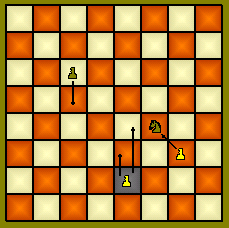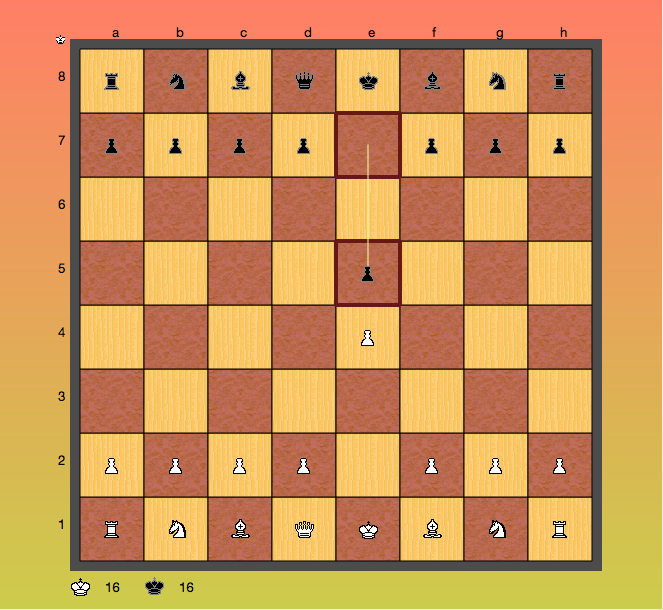Rules
- The ultimate aim in the game of chess is to win by trapping your opponent's king. (This is called checkmate)
- White is always first to move and players take turns alternately moving one piece at a time. Movement is required.
- Each type of piece has its own method of movement. A piece may be moved to another position or may capture an opponent's piece.
This is done by landing on the appropriate square with the moving piece and removing the defending piece from play.
- With the exception of the knight, a piece may not move over or through any of the other pieces.
- Stalemate is considered a tie. A stalemate occurs when a player's only move is to place his own king in check, but it's current square is not threatened.
- A draw also results when the only two pieces on the board are Kings, regardless of their position.
 Pawn Pawn
There are eight pawns situated on each side of the board. They are the least powerful piece on the chess board, but have the potential to become equal to the most powerful.
Pawns cannot move backward or sideways, but must move straight ahead unless they are taking another piece.
Generally pawns move only one square at a time. The exception is the first time a pawn is moved, it may move forward two squares as long as there are no obstructing pieces. A pawn cannot take a piece directly in front of him but only one at a forward angle. In the diagram above the green dots show where the pawn may move and the red dots show where the pawn may capture a piece. In the case of a capture the pawn replaces the captured piece and the captured piece is removed from play.
Should a pawn get all the way across the board to reach the opponent's edge of the table, it will be promoted. The pawn may now become any piece that the moving player desires (except a king or pawn

 Rook Rook
The rook, shaped like a castle, is one of the more powerful pieces on the board. The rooks, grouped with the queen, are often thought of as the "major pieces". Rooks are worth a bishop or a knight plus two pawns.
The rook can move any number of squares in a straight line along any column or row. They CANNOT move diagonally
 Knight Knight
The knight is the only piece on the board that may jump over other pieces. This gives it a degree of flexibility that makes it a powerful piece.
The knight can be thought of as moving one square along any rank or file and then at an angle. The knight's movement can also be viewed as an "L" laid out at any horizontal or vertical angle.
The squares to where the knight can move are all of the opposite colored squares two steps away from his starting square.
 Bishop Bishop
The bishop may move any number of squares in a diagonal direction until it is prevented from continuing by another piece.
Each player begins with two bishops, one originally situated on a light square, the other on a dark square. Because of the nature of their movement, the bishops always remain on the same colored squares.
 Queen Queen
The queen is the most powerful piece on the chessboard. She can move as many squares as she desires and in any direction (barring any obstructions). She captures in the same way that she moves, replacing the unlucky opposing piece that got in her way.
 King King
Though not the most powerful piece on the board, the king is the most vital, for once he is lost the game is lost.
The king can only move one square in any direction. There is only one restriction on his movement - he may not move into a position where he may be captured by an opposing piece. Because of this rule, two kings may never stand next to each other or capture each other.
Castling
Castling is a special defensive maneuver. It is the only time in the game when more than one piece may be moved during a turn.
This move was invented in the 1500's to help speed up the game and to help balance the offense and defense.
The castling move has some fairly rigid caveats:
- It can only occur if there are no pieces standing between the king and the rook.
- Neither king nor rook may have moved from its original position.
- There can be no opposing piece that could possibly capture the king in his original square, the square he moves through or the square that he ends the turn.
The king moves two squares toward the rook he intends to castle with. The rook then moves to the square through which the king passed.
En Passant
It can only occur when a player exercises his option to move his pawn two squares on its initial movement. When this happens, the opposing player has the option to take the moved pawn "en passant" as if it had only moved one square. This option, though, only stays open for one move.
The en passant move was developed after pawns were allowed to move more than one square on their initial move. This was done to make sure they retained some of the restrictions imposed by slow movement, while at the same time speeding up the game.
|





